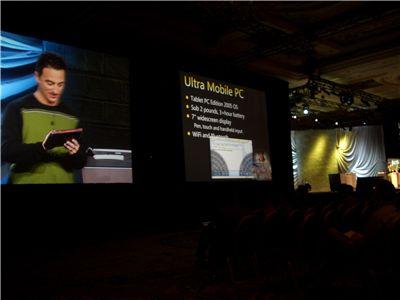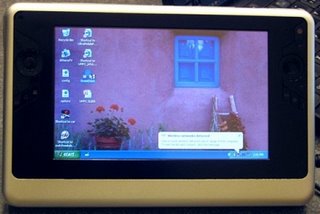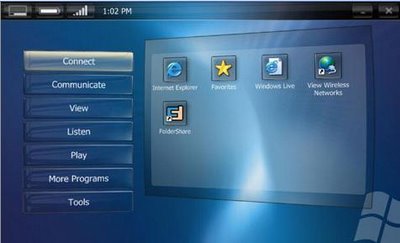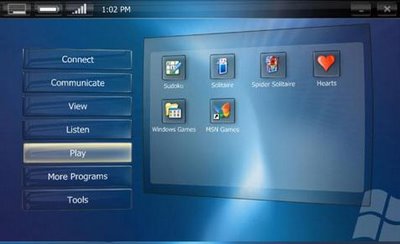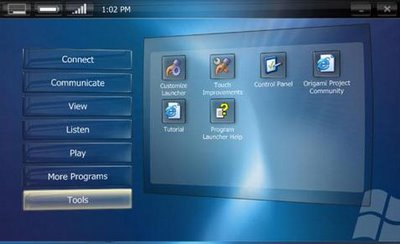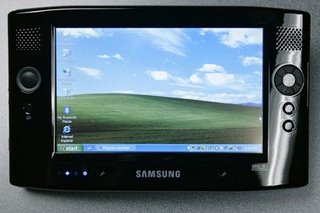Microsoft believes consumers are looking for an uncompromised level of computing on the go. Thus, it began the process of developing what is now called the Ultra-Mobile PC back in 2002. Heading that team is Otto Berkes, the device's architect and now general manager of the UMPC team.
In an interview with BetaNews, Berkes says the impetus behind the creation of this new type of computing device has to do with several changes in the industry. Today's desktops and laptops are not designed for true "on the go" use, he explained, but people are increasingly going mobile.
The UMPC opens up a wider array of computing scenarios, including easier in-car use, or walking down a hall between meetings. The device does not take away from the PC experience, because it is running a full version of Windows, Berkes added. "It looks like something you'd pick up with two hands."
Although it may appear to be, the UMPC is not intended to be a replacement for any other device.
"It's not the death of the laptop," Berkes argued. He said laptops were still great tools for what he called "destination end-points." While in transit, it would be easier to use the UMPC, while upon arriving at a destination, the laptop would still likely be the better tool.
The same goes for Microsoft's Tablet PC concept. "Tablets will stay on the market," Berkes assured. "We are using Tablet PC technology, but delivering it in a different way." This new implementation would come in the form of the Microsoft Touch Pack, a set of applications and services intended to take advantage of UMPC's touch screen and feature set.
Berkes also took issue with criticisms that the device is too big, or a rehash of prior form factors like the PepperPad and OQO, which have both failed to find a market.
Very few devices are actually appropriate for the pocket, he said, and the fact that the UMPC is a fully functional Windows PC with capabilities to connect to a multitude of devices just like a regular PC sets it apart from the crowd.
Another difference from even Microsoft's own failures -- such as Windows Smart Displays -- is the fact that it's a PC at heart. "The family tree is still the PC. It will be able to feed off of the huge Windows ecosystem," Berkes explained. Thus, he said, the product provides a huge amount of value over other devices.
To ensure the impression of value, Microsoft played a large part in the design of the UMPC hardware platform. By providing prototypes and reference designs, as well as offering guidance in manufacturing, the company hopes to avoid problems.
"With the UMPC being more device-like, the software and hardware need to be coordinated," Berkes said, indicating that Microsoft has learned from the mistakes of its hands-off approach in digital media devices.
Many analysts have said that Microsoft allowed too much leeway among its partners in designing those devices, which resulted in issues with its PlaysForSure technology and compatibility with Windows Media Player. Apple's iPod in the meantime secured its dominance through a unified platform.
Microsoft will not rule over designs with an iron fist; the company will only mandate some functions and leave the rest up to the manufacturer. This includes the options for a keyboard, rather than the DialKeys thumb input method that is included in the UMPC Touch Pack software.
The same hands-off approach would cover peripherals, with Berkes saying the company expects "OEMs to provide their own peripheral solutions," as their accessories "would be designed best for a particular model." He would not rule out, however, accessories being produced by Microsoft.
Current generation UMPCs are not perfect, Berkes conceded, especially in the area of battery life. The devices are expected to only operate for three to four hours on a battery charge, which is slightly below the average of today's laptop. He said this has become a focus of future devices based on the platform.
"The industry recognizes the physical limitations of battery life with today's PC architecture," Berkes said. Efforts are underway to remedy the issue, he added, mentioning Intel's recent announcements that it was investing heavily in manufacturing more efficient processors. "This translates directly into better battery life."
Another area of concern among consumers is price, which in the current models ranges from $599 to $999 USD. Berkes said the market would largely determine the pricing, and as more of the devices are sold, the cost of manufacturing and purchasing would fall. "My personal hope is that [the UMPC] becomes so affordable that anyone who wants one would be able to purchase one," he said.
Berkes also touched on the topic of a Windows Vista upgrade path. The first Ultra-Mobile PCs will ship with Windows XP, as the launch comes six to eight months away from the expected release of Microsoft's next-generation operating system.
Berkes said that the UMPC would be part of a "Vista Ready" program that Microsoft plans to roll out shortly. The program, much like ones the company has employed previously, would aim to assure consumers that the hardware they are purchasing is ready to run the next Windows release.
"We are, and have been, testing Vista in our labs to ensure there is a smooth upgrade path," he assured.
Even in its short life, the device has already assembled a litany of critiques from the industry. On Tuesday, research firm Gartner released a report calling the device a "tweener," and said that low battery life, high price and a non-Vista operating system will probably doom the product early on.
"For these reasons, we question the timing of this launch: Why rush this to market before it is ready to succeed?" Gartner analysts asked in the report. "Despite the promise of this device category, the UMPC as currently conceived will fail to achieve mainstream success."
According to Gartner, the device needs to meet several requirements in order to become successful, including an eight-hour battery and sub-$400 price, compelling content bundles, better shell running on top of Vista, better text entry, and "dock-and-go" syncing.
But Berkes remains confident that users will find the UMPC a good fit with their increasingly mobile lifestyles. "It's a very different device than what's available today."




